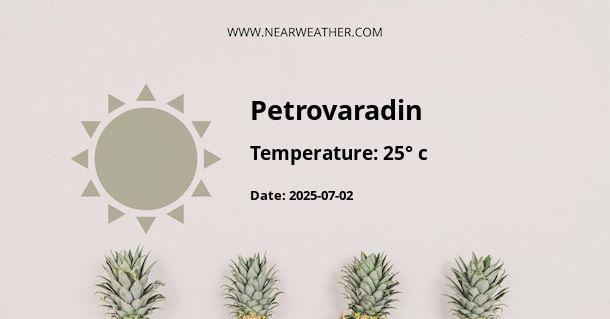Understanding Petrovaradin's Climate and Weather Patterns Year-Round
Petrovaradin, a historic town on the right bank of the Danube river, is an integral part of the city of Novi Sad, the second-largest city in Serbia. Known for its iconic Petrovaradin Fortress and as a cultural hub, particularly for hosting the EXIT music festival, it boasts a temperate continental climate. Understanding this region's climate and weather patterns is crucial for residents, tourists, and event planners alike.
The Four Distinct Seasons of Petrovaradin
In Petrovaradin, the year is characterized by four distinct seasons, each with its unique weather patterns:
- Spring: March to May in Petrovaradin is a period of transition with variable weather. The temperatures gradually rise from an average low of around 2°C (36°F) in March to more comfortable conditions by the end of May, with highs reaching up to 24°C (75°F).
- Summer: June to August is typically the warmest time of the year, with temperatures often soaring above 30°C (86°F). This season is characterized by longer days and occasional heatwaves. However, being close to the Danube can provide a cooling effect during hot summer nights.
- Autumn: September to November sees a steady decline in temperatures and daylight hours. The weather becomes cooler and more unpredictable, with chances of rain increasing as the season progresses.
- Winter: December to February in Petrovaradin can be quite cold with average temperatures ranging from -2°C to 5°C (28°F to 41°F). Snowfall is common, and foggy conditions can occur due to the proximity of the Danube river.
Precipitation and Humidity Patterns
Petrovaradin experiences a fair distribution of rainfall throughout the year. It avoids the extremes of a Mediterranean climate and maintains moderate humidity levels due to its continental characteristics. The spring and late autumn are particularly known for heavier precipitation. To illustrate the precipitation patterns, consider the following monthly averages:
| Month | Average Precipitation (mm) |
|---|---|
| January | 37 |
| February | 36 |
| March | 40 |
These figures demonstrate that, while there is no distinct dry season in Petrovaradin, the distribution of rain can impact the scheduling of outdoor events and activities, hence the emphasis on detailed monthly weather data.
Seasonal Wind Patterns
Wind patterns in Petrovaradin are influenced by regional topography and global weather phenomena. The region experiences different types of winds depending on the season:
Košava Wind: A cold and dry southeastern wind, the Košava is most prominent from autumn to spring. It can last for several days and reach high speeds, influencing temperatures and potentially causing discomfort for those unprepared for its forceful gusts.
Local winds, such as the aforementioned Košava, are significant factors that contribute to the unique climatological fingerprint of Petrovaradin.
Extreme Weather Events and Climate Concerns
With changing climate patterns worldwide, Petrovaradin, like many regions, is not immune to extreme weather events. Heatwaves and intense storms have periodically affected the area. In recent years, concerns about climate change have intensified these occurrences, requiring constant monitoring and adaptation strategies.
What This Means For Petrovaradin's Residents and Visitors
Understanding the climate and weather peculiarities of Petrovaradin is crucial for those who live there and those planning to visit. It can impact decision-making related to agriculture, outdoor planning for events like the EXIT festival, and tourists' itinerary planning. Knowing the seasonal variations helps in better preparing for what to expect during different times of the year.
Monitoring Weather and Climate Data
Reliable meteorological data are essential for accurate weather forecasting, and numerous resources are available for Petrovaradin and the surrounding regions. Local weather stations, along with national meteorological services, provide up-to-date forecasts and warnings when adverse weather conditions are expected. It is beneficial for locals and visitors alike to stay informed through these channels.
Sustainable Practices in Response to Climate Patterns
Given the global attention to climate change, Petrovaradin, like many communities, has an opportunity to engage in sustainable practices that could mitigate some of the adverse effects of extreme weather. Developing green infrastructure, promoting cleaner energy sources, and enhancing the town's resilience to climate change are all vital steps in ensuring the continued prosperity of the area.
Conclusion
In conclusion, the town of Petrovaradin experiences a temperate continental climate with distinct seasons and a fairly even distribution of precipitation throughout the year. Understanding these patterns is crucial for both long-term residents and short-term visitors, especially those attending annual events such as the EXIT festival. As climate change continues to influence weather patterns, it becomes even more important to monitor, prepare for, and adapt to these environmental changes. With responsible actions and informed planning, Petrovaradin can continue to be an inviting and welcoming destination throughout the year.
A - Petrovaradin's Latitude is 45.246670 & Longitude is 19.879440.
A - Weather in Petrovaradin is 2° today.
A - Climate Conditions in Petrovaradin shows overcast clouds today.
A - Humidity in Petrovaradin is 95% today.
A - Wind speed in Petrovaradin is 16.45 km/h, flowing at 274° wind direction. today.
